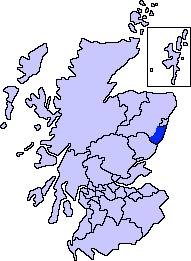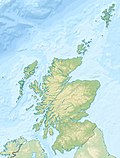
Stonehaven is a town in Scotland. It lies on Scotland's northeast coast and had a population of 11,602 at the 2011 Census. After the demise of the town of Kincardine, which was gradually abandoned after the destruction of its royal castle in the Wars of Independence, the Scottish Parliament made Stonehaven the successor county town of Kincardineshire. It is currently administered as part of the Aberdeenshire Council Area. Stonehaven had grown around an Iron Age fishing village, now the "Auld Toon", and expanded inland from the seaside. As late as the 16th century, old maps indicate the town was called Stonehyve, Stonehive, Timothy Pont also adding the alternative Duniness. It is known informally to locals as Stoney.

The Battle of Dun Nechtain or Battle of Nechtansmere was fought between the Picts, led by King Bridei Mac Bili, and the Northumbrians, led by King Ecgfrith, on 20 May 685.

Kincardineshire, also known as the Mearns, is a historic county, registration county and lieutenancy area on the coast of northeast Scotland. It is bounded by Aberdeenshire on the north and west, and by Angus on the south.

Bennachie is a range of hills in Aberdeenshire, Scotland. It has several tops, the highest of which, Oxen Craig, has a height of 528 metres (1,732 ft). Though not particularly high, compared to other peaks within Scotland, the mountain is very prominent, owing to its isolation and the relative flatness of the surrounding terrain, and dominates the skyline from several viewpoints.

Inverurie is a town in Aberdeenshire, Scotland at the confluence of the rivers Ury and Don, about 16 miles (26 km) north-west of Aberdeen.

Dunnottar Castle is a ruined medieval fortress located upon a rocky headland on the north-eastern coast of Scotland, about 2 miles south of Stonehaven. The surviving buildings are largely of the 15th and 16th centuries, but the site is believed to have been fortified in the Early Middle Ages. Dunnottar has played a prominent role in the history of Scotland through to the 18th-century Jacobite risings because of its strategic location and defensive strength.

A Pictish stone is a type of monumental stele, generally carved or incised with symbols or designs. A few have ogham inscriptions. Located in Scotland, mostly north of the Clyde-Forth line and on the Eastern side of the country, these stones are the most visible remaining evidence of the Picts and are thought to date from the 6th to 9th century, a period during which the Picts became Christianized. The earlier stones have no parallels from the rest of the British Isles, but the later forms are variations within a wider Insular tradition of monumental stones such as high crosses. About 350 objects classified as Pictish stones have survived, the earlier examples of which holding by far the greatest number of surviving examples of the mysterious symbols, which have long intrigued scholars.

Kincardine and Mearns is one of six area committees of the Aberdeenshire council area in Scotland. It has a population of 38,506. There are significant natural features in this district including rivers, forests, mountains and bogs.

The Hilton of Cadboll Stone is a Class II Pictish stone discovered at Hilton of Cadboll, on the East coast of the Tarbat Peninsula in Easter Ross, Scotland. It is one of the most magnificent of all Pictish cross-slabs. On the seaward-facing side was a Christian cross, and on the landward facing side are secular depictions. The latter are carved below the Pictish symbols of crescent and v-rod and double disc and Z-rod: a hunting scene including a woman wearing a large penannular brooch riding side-saddle. Like other similar stones, it can be dated to about 800 AD.
Leslie Alcock was Professor of Archaeology at the University of Glasgow, and one of the leading archaeologists of Early Medieval Britain. His major excavations included Dinas Powys hill fort in Wales, Cadbury Castle in Somerset and a series of major hillforts in Scotland.
Crawton is a former fishing community on the southeast Aberdeenshire coast in Scotland, deserted since 1927.

Bowdun Head is a headland landform on the North Sea coast approximately one kilometre south of Stonehaven, Scotland.(Ordnance Survey, 2004) Slightly to the north is another headland, Downie Point. Somewhat to the south along the coast is Dunnottar Castle on the far side of the bay of Castle Haven. Other historic structures in the general vicinity include the Stonehaven Tolbooth, Fetteresso Castle, the Chapel of St. Mary and St. Nathalan and Muchalls Castle. There is considerable prehistory associated with the local area including a Pictish hill fort on the sea stack of Dunnicaer immediately to the north, and Bronze Age archaeological sites at Fetteresso and Spurryhillock, both somewhat inland of Bowdun Head.
Christian Maclagan was a Scottish antiquarian and early archaeologist. She is known for her collection of rubbings of Celtic crosses and Pictish stones from across Scotland, and was a pioneer of stratigraphic excavation. Although she lost the use of her right hand due to a medical condition she nevertheless produced numerous drawings, sketches and paintings with her left hand. She took action to help those affected by poverty in Stirling. She refused to sit for portraits although one obituary described her as tall. She was a suffragist. She wrote an autobiography but the script remains lost. She was nominated to be one of Scotland's Heroines honoured at the National Wallace Monument's Hall of Heroes. She died in Ravenscroft, Stirling.

Kinneddar is a small settlement on the outskirts of Lossiemouth in Moray, Scotland, near the main entrance to RAF Lossiemouth. Long predating the modern town of Lossiemouth, Kinneddar was a major monastic centre for the Pictish kingdom of Fortriu from the 6th or 7th centuries, and the source of the important collection of Pictish stones called the Drainie Carved Stones. The Kirk of Kinneddar was the cathedral of the Diocese of Moray between 1187 and 1208, and remained an important centre of diocesan administration and residence of the Bishop of Moray through the 13th and 14th centuries.
The Aberlemno Sculptured Stones are a series of Pictish standing stones originating in and around the village of Aberlemno, Angus, Scotland. Three are located in the village and a fourth, found in 1962, is on display in The McManus in Dundee. They date from the Early Medieval period. A fifth stone standing in the village has signs of carving, but is of unknown authenticity as a Pictish artefact.

Craig Phadrig is a forested hill on the western edge of Inverness, Scotland. A hill fort on the summit is generally supposed to have been the base of the Pictish king Bridei mac Maelchon. The hill rises to 172 metres (564 ft) above sea level, and overlooks the Beauly Firth to the north and the mouth of the River Ness to the north-east. The hill is currently owned and managed by Forestry and Land Scotland.

Cé was a Pictish territory recorded during the Early Medieval period and located in the area of modern-day Aberdeenshire, Scotland.

The Burghead Bulls are a group of carved Pictish stones from the site of Burghead Fort in Moray, Scotland, each featuring an incised image of a bull. Up to 30 were discovered during the demolition of the fort to create the town of Burghead in the 19th century, but most were lost when they were used to build the harbour quayside. Six remain: two in the Visitor Centre in Burghead, two in Elgin Museum, one in the National Museum of Scotland in Edinburgh, and one in the British Museum in London.

The Govan Stones is an internationally-important museum collection of early-medieval carved stones displayed at Govan Old Parish Church in Glasgow, Scotland.

Alexander Thomson of Banchory FRSE (1798–1868) was a 19th-century Scottish advocate, agriculturalist, antiquary, author, philanthropist and traveller. He owned an estate at Banchory-Devenick in Aberdeenshire. After qualifying as an advocate in Edinburgh he returned to the estate and did not pursue a career at the bar preferring to follow the life of a country gentleman. He travelled extensively in Europe, spending many years studying overseas. He settled crofters on his estate and planted many trees. His position in life allowed to give time to many interests including antiquarian studies, geology, biology and social reform. He attempted to unite Marischal and King's Colleges in Aberdeen University. At the Dirsuption he sided with the Free Church and was a prominent leader in that cause. He died in 1868 and bequeathed a sizeable museum and collection of books to the church. He also gave a substantial amount of money to set up a Free Church College in Aberdeen.





















